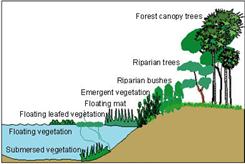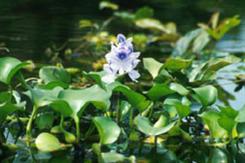Macrophytes
Macrophytes (literally ‘large plants’) are individual aquatic plants that can be seen by the unaided eye, and are categorised according to where and how they grow.
Rooted macrophytes are rooted in the riverbed or lake substrate, and are thus restricted to areas where flow is low enough to permit fine sediments to accumulate. Rooted macrophytes may have leaves entirely submerged (under the water), floating on the surface, or emergent above the surface. In turbid water, little light penetrates and photosynthesis is restricted, hence only plants with floating or emergent leaves can thrive. Rooted macrophytes may extract nutrients from the substrate as well as absorbing them from the water as algae do.
Floating aquatic macrophytes are rootless plants that persist only in backwater areas where the flow slackens—otherwise they are carried downstream. Because their photosynthetic surfaces are above the water surface, these plants can grow in deep, turbid water and places where rooting sites are sparse.
Macrophyte abundance can fluctuate seasonally as a result of scouring of the bottom sediments and washout of plants during heavy rains. For this reason, the number of macrophytes in river channels generally peaks during periods of low flow.
Aquatic macrophytes are important in many aquatic systems, especially wetlands, slower-moving water in streams and rivers, and in shallower areas of lakes. Aquatic macrophytes add three-dimensional complexity to aquatic habitat, and can provide habitat, refuge, and spawning areas for animals such as aquatic insects and fish, as well as a surface for periphyton growth. As they are primary producers, aquatic macrophytes produce organic matter which can be eaten by some fish; however, most of this plant material is unpalatable to herbivores while it is alive. Energy is transferred to animals primarily when the dead plant tissue and associated decomposers are eaten.
Large populations of aquatic macrophytes can harm aquatic ecosystems and the people that rely on them. In some cases, floating plants are so numerous that they form dense mats covering the water surface. Their buoyant leaf crowns merge above the surface while the root masses dangle below into the water. The interlocking vegetation mat blocks sunlight and prevents the growth of other plants. In extreme cases, the underlying water becomes deoxygenated, and floating plants create a nuisance by inhibiting the passage of boats and interfering with fishing. Invasive species of macrophytes, particularly, can disrupt natural aquatic ecosystems.
Water Hyacinth
Water hyacinth (Eichhornia crassipes) is a floating macrophyte native to Brazil. Transported by humans to several regions around the world, including the Orange-Senqu River basin, major infestations of water hyacinth have occurred in Lesotho and South Africa and biological control programs have been in place in South Africa since 1973 (Hill and Cilliers 1999). The seeds of water hyacinth can be carried along with silt downstream by water currents, leading to the downstream spread of the plant; seeds are also spread by animals (Howard and Harley 1998) Dense mats of water hyacinth cover the water surface in some areas, reducing the amount of light entering the water. Without sufficient light, phytoplankton and periphyton growth is reduced, leading to a decline in the food base of organisms that consume these species. The reduction of phytoplankton and periphyton growth also reduces the oxygen concentration and increases the carbon dioxide concentration, which can have severe effects such as fish kills.
Riparian Vegetation
Riparian vegetation is plant growth that lines the banks of rivers and other inland waterbodies. These plants protect river banks from wave action and erosion, and offer shelter, feeding, and breeding areas for fish, birds and other organisms. Riparian vegetation can provide considerable organic matter to streams and rivers in the form of leaves, twigs, etc. The riparian zone can contain a variety of plants – from grasses to trees – often in a gradual transition with distance from the bank, reflecting different species’ tolerance for soil saturation.
 A schematic representation of riparian vegetation types. Source:NTEAP 2007 ( click to enlarge ) |
 Water Hyacinth. Source:Nile RAK 2007 ( click to enlarge ) |
